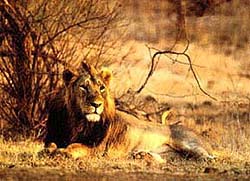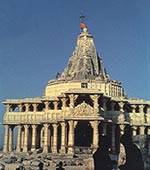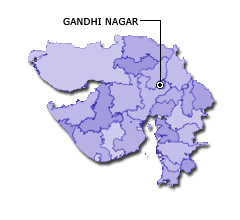Gujarat (Gandhinagar)
| Particulars | Description |
|---|---|
 Area Area |
1,96,024 sq. km |
 opulation opulation |
6,03,83,628 * |
 Capital Capital |
Gandhinagar |
 Principal Languages Principal Languages |
Gujarati |
History and Geography
The history of Gujarat goes back to 2000 B.C. It is believed that Lord Krishna left Mathura to settle on the west coast of Saurashtra, which later came to be known as Dwarka, the gateway. Later, it saw various kingdoms: Mauryas, Guptas, Pratiharas and others. It was with Chalukya (Solankis) that Gujarat witnessed progress and prosperity. In spite of the plundering of Mahmud Ghazni, the Chalukya kings were able to maintain general prosperity and well-being of the State. After this glorious respite, Gujarat faced troubled times under the Muslims, Marathas and the British rule. Before Independence, the present territories of Gujarat used to be in two parts, the British and the Princely territories. With the re-organisation of the States, the Union of the States of Saurashtra and the Union Territory of Kachchh along with the former British, Gujarat became a part of the biggest bilingual State of Bombay. The present State of Gujarat came into being on May, 1960. It is situated on the west coast of India. The state is bounded by the Arabian Sea on the west, Pakistan and Rajasthan in the north and north-east respectively, Madhya Pradesh in the south-east and Maharashtra in the south.
Agriculture
The State Government has adopted a pro-farmer approach to achieve long term growth. The Government is giving high priority to water conservation and water management activities in order to provide rain water to the arid areas of the state. 'Krishi Mahotsav' is being organized every year to make aware the farmers with modern technologies and methods of scientific farming. In the year 2010, the state has witnessed 63.50 lakh MT production of food crops, 30.5 lakh MT production of oilseeds and 104.55 lakh bale production of cotton.
Soil health care has been given to about 20.42 lakh farmers while the Kisan Credit Card has been given to more than 24 lakh farmers so far. Gujarat is standing top in the country with the 100 per cent success in providing biometric cards to the fishermen with a view to make them identifiable.
Industry
In the golden jubilee year (2010-11) of the state, the state government organized 'Vibarant Gujarat Global Investors Summit'(VGGIS) which was truly matchless in the financial history of our nation. The summit attracted investors from across the world. As many as 8,380 MoUs were signed which is expected to fetch an investment of around Rs.20.83 lakh crore. This will also translate into a job opportunity for lakhs of youths of the state, which is going to prove a distinctive achievement of the state.
The number of registered working factories in the State were 24453 (Provisional) at the end of 2009 with the average daily employment up to 12.58 lakh. During the year 2009-10 (up to October, 2009), 2091 new Joint Stock Companies with an authorized capital of Rs.608 crore were registered in the State. Hence up to October, 2009, 57104 Joint Stock Companies were registered in the State. Gujarat Industrial Development Corporation (GIDs) has been assigned the role of developing industrial estates with infrastructure facilities. At the end of year 2009-10 GIDs sanctioned 262 industrial estates.
Irrigation and Power
The total irrigation potential through surface water as well as ground water has been assessed at 64.88 lakh hectare including 17.92 lakh hectare through Sardar Sarovar (Narmada) Project. The total irrigation potential created up to June 2010 was worked out to 31.65 lakh hectare. The maximum utilisation was estimated at 23.79 lakh hectare up to June 2010.
Electricity
Gujarat has become the first state in the nation to start a separate department of 'climate change' to tackle the issue of global warming.
Gujarat has become the first state in the country to come with solar policy in 2009, with a view to give boost to the solar energy sector.
With a view to provide the benefits of electricity to the weaker sections of the society, the state government provided as many as 2,12,236 power connections by December 2010 under various schemes.
The total installed capacity for the state including central sector project increased to 12512 MW as on October 2010. All the villages have been covered under the scheme Jyoti Gram Yojana of Gujarat State Government.
Transport
Roads: Road network is playing crucial role in the development of the state. As a novel approach, the state government has involved private sector in the building of a sound road network. With a view to meet the needs of increasing population, BRTS facility has been started in the state's mega city Ahmedabad for speedy commuting.
The total length of road (except Non-plan, Community, Urban and Projects roads) was 74,112 km by the end of 2007-08.
Aviation: At present, the state has got 20 airports in all. Gujarat Government is in the process of getting 11 new airports for the pilgrim places of the state which will connect all the major pilgrim places like Pallitana, Dwarka, Ambaji and others on the air-route.
The main airport of Gujarat at Ahmadabad is connected with Mumbai, Delhi and other cities by daily services. Ahmedabad airport has now got up the status of an International Airport. Other domestic airports as Vadodara, Surat, Bhavnagar, Bhuj, Jamnagar and Rajkot.
Ports: During the last decade, Gujarat has acquired a status of an important maritime state of the country. Nearly 80 per cent of the total traffic on the non-major ports and about 25 per cent of the total traffic on the all the ports of India is being recorded on the ports of Gujarat, which is a matter of pride for the state.
Gujarat has 41 minor and intermediate and one major port is Kandla port. The intermediate and minor ports of Gujarat handled a total of cargo of 2055.40 lakh tones whereas Kandla port handled cargo of 795.00 lakh tones during year 2009-10.
Festivals
Tarnetar fair is held at village Tarnetar in the honour of Lord Shiva on the 4th, 5th and 6th days of the bright half of the month of Bhadrapada (August/September). Madhavrai fair at Madhavpur near Porbandar is, held to celebrate the marriage by elopement of Lord Krishna and Rukmani, on the ninth day of the bright half of the month of Chaitra (March/April). Ambaji fair dedicated to Amba, mother goddess is held in Banaskantha district. The biggest annual fair, Janmashtami the birthday of Lord Krishna is celebrated at Dwarka and Dakor with great enthusiasm. Other festivals are Makar-Sankranti, Navratri, Dangi darbar, Shamlaji fair, Bhavnath fair, etc.
Tourist Centres

Lion Sanctuary of Gir Forest
Religious spots like Dwarka, Somnath, Palitana, Pavagadh, Ambaji, Bhadreshwar, Shamlaji, Taranga and Girnar; Porbandar, birth place of Mahatma Gandhi, places of memorable monuments of architectural and, archaeological surprises like Patan, Siddhpur Ghurnli, Dabhoi, Vadnagar, Modhera, Lothal and Ahmedabad; beautiful beaches like Ahmadpur-Mandvi, Chorwad, Ubharat and Tithal; the hill station Saputara; lion sanctuary of Gir Forest and wild ass sanctuary in Kachchh area are major tourist attractions in the State.

Somnath Temple
The Somnath temple located in Prabhas Patan near Veraval in Saurashtra on the western coast of Gujarat, India, is the first among the twelve Jyotirlinga shrines of Shiva.[1] It is an important pilgrimage and tourist spot. The temple is considered sacred due to the various legends connected to it. Somnath means "Lord of the Soma", an epithet of Shiva.
* As per 2011 Census (Provisional Data)
States and Capitals
Union Territories
* S (Summer) and * W (Winter)

